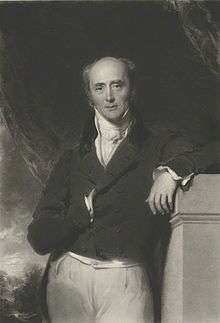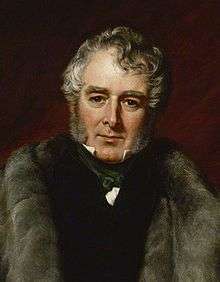| Office | Name | Date | Notes |
|---|
Prime Minister,
First Lord of the Treasury
and Leader of the House of Lords | The Earl Grey | 22 November 1830 – 9 July 1834 | The Government resigned 8 May 1832 and resumed 17 May 1832 |
| The Viscount Melbourne | 16 July 1834 – 14 November 1834 | |
| Chancellor of the Exchequer | Viscount Althorp | 22 November 1830 | also Leader of the House of Commons until 1834 |
| Financial Secretary to the Treasury | Thomas Spring-Rice | 26 November 1830 | |
| Francis Baring | 6 June 1834 |
| Parliamentary Secretary to the Treasury | Edward Ellice | 26 November 1830 | |
| Charles Wood | 10 August 1832 |
| Junior Lords of the Treasury | The Lord Nugent | 22 November 1830 – 22 November 1832 | |
| Robert Vernon Smith | 22 November 1830 – 14 November 1834 |
| Francis Baring | 22 November 1830 – 6 June 1834 |
| Hon. George Ponsonby | 22 November 1830 – 14 November 1834 |
| Thomas Francis Kennedy | 22 November 1832 – 9 April 1834 |
| Robert Graham | 9 April 1834 – 14 November 1834 |
| George Byng | 20 June 1834 – 14 November 1834 |
| Lord Chancellor | The Lord Brougham and Vaux | 22 November 1830 | |
| Lord President of the Council | The Marquess of Lansdowne | 22 November 1830 | |
| Lord Privy Seal | The Lord Durham | 22 November 1830 | created Earl of Durham 23 March 1833 |
| The Earl of Ripon | 3 April 1833 | |
| The Earl of Carlisle | 5 June 1834 |
| The Earl of Mulgrave | 30 July 1834 |
| Secretary of State for the Home Department | The Viscount Melbourne | 22 November 1830 | |
| Viscount Duncannon | 19 July 1834 |
| Under-Secretary of State for the Home Department | Hon. George Lamb | 22 November 1830 | |
| Viscount Howick | 13 January 1834 |
| Edward Stanley | 23 July 1834 |
| Secretary of State for Foreign Affairs | The Viscount Palmerston | 22 November 1830 | |
| Under-Secretary of State for Foreign Affairs | Sir George Shee, Bt | 26 November 1830 | |
| Viscount Fordwich | 13 November 1834 |
| Secretary of State for War and the Colonies | The Viscount Goderich | 22 November 1830 | |
| Hon. Edward Smith-Stanley | 3 April 1833 |
| Thomas Spring Rice | 5 June 1834 |
| Under-Secretary of State for War and the Colonies | Viscount Howick | 23 November 1830 | |
| Sir John Shaw-Lefevre | 13 January 1834 |
| Sir George Grey, Bt | 16 July 1834 |
| First Lord of the Admiralty | Sir James Graham, Bt | 22 November 1830 | |
| The Lord Auckland | 7 June 1834 |
| First Secretary to the Admiralty | Hon. George Elliot | 29 November 1830 | |
| Civil Lord of the Admiralty | Henry Labouchere | 8 June 1832 | |
| President of the Board of Control | Charles Grant | 1 December 1830 | |
| Secretary to the Board of Control | Viscount Sandon | 18 December 1830 | |
| Thomas Hyde Villiers | 18 May 1831 |
| Thomas Babington Macaulay | 19 December 1832 |
| Robert Gordon | 26 December 1833 – 14 November 1834 | Joint Secretaries from 22 April 1834 |
| James Alexander Stewart-Mackenzie | 22 April 1834 – 14 November 1834 |
| Chancellor of the Duchy of Lancaster | The Lord Holland | 25 November 1830 | |
| Chief Secretary for Ireland | Hon. Edward Smith-Stanley | 29 November 1830 | entered the Cabinet 16 June 1831 |
| Sir John Hobhouse, Bt | 29 March 1833 | |
| Edward Littleton | May 1833 | |
| Lord Lieutenant of Ireland | The Marquess of Anglesey | 4 December 1830 | |
| The Marquess Wellesley | 12 September 1833 |
| Master of the Mint | The Lord Auckland | 14 December 1830 | |
| James Abercromby | 13 June 1834 |
| Paymaster of the Forces | Lord John Russell | 16 December 1830 | entered the Cabinet 16 June 1831; also Leader of the House of Commons 1834 |
| Minister without Portfolio | The Earl of Carlisle | 22 November 1830 – 5 June 1834 | |
| Postmaster-General | The Duke of Richmond | 11 December 1830 | |
| The Marquess Conyngham | 5 July 1834 |
| President of the Board of Trade | The Lord Auckland | 22 November 1830 | |
| Charles Poulett Thomson | 5 June 1834 |
| Vice-President of the Board of Trade | Charles Poulett Thomson | 22 November 1830 | |
| Henry Labouchere | 5 June 1834 |
| Secretary at War | Charles Watkin Williams-Wynn | 30 November 1830 | |
| Sir Henry Parnell, Bt | 4 April 1831 |
| Sir John Hobhouse, Bt | 1 February 1832 |
| Edward Ellice | 6 April 1833 | entered the Cabinet 20 June 1834 |
| First Commissioner of Woods and Forests | George Agar-Ellis | 2 December 1830 | |
| Viscount Duncannon | 7 February 1831 |
| Sir John Hobhouse, Bt | 22 July 1834 |
| Treasurer of the Navy | Charles Poulett Thomson | 30 November 1830 | |
| Master-General of the Ordnance | Sir James Kempt | 11 December 1830 | |
| Treasurer of the Ordnance | Thomas Creevey | 31 January 1831 | |
| Surveyor-General of the Ordnance | William Leader Maberly | 12 January 1831 | |
| Charles Richard Fox | 30 November 1832 |
| Clerk of the Ordnance | Charles Tennyson | 30 December 1830 | |
| Thomas Francis Kennedy | 8 February 1832 |
| William Leader Maberly | 30 November 1832 |
| Andrew Leith Hay | 19 June 1834 |
| Storekeeper of the Ordnance | Henry Duncan | 30 December 1830 | |
| Attorney General | Sir Thomas Denman | 24 November 1830 | |
| Sir William Horne | 26 November 1832 |
| Sir John Campbell | 1 March 1834 |
| Solicitor General | Sir William Horne | 24 November 1830 | |
| Sir John Campbell | 26 November 1832 |
| Sir Charles Pepys | 25 February 1834 |
| Sir Robert Rolfe | 6 November 1834 |
| Judge Advocate General | Sir Robert Grant | 24 November 1830 | |
| Robert Cutlar Fergusson | 19 June 1834 |
| Lord Advocate | Francis Jeffrey | 3 December 1830 | |
| John Murray | 17 May 1834 |
| Solicitor General for Scotland | Henry Cockburn | 3 December 1830 | |
| Andrew Skene | 5 November 1834 |
| Attorney General for Ireland | Edward Pennefather | 23 December 1830 | |
| Francis Blackburne | 11 January 1831 |
| Solicitor General for Ireland | Philip Cecil Crampton | 23 December 1830 | |
| Michael O'Loghlen | 21 October 1834 |
| Lord Steward of the Household | The Marquess Wellesley | 23 November 1830 | |
| The Duke of Argyll | 11 September 1833 |
| Lord Chamberlain of the Household | The Duke of Devonshire | 22 November 1830 | |
| Vice-Chamberlain of the Household | Earl of Belfast | 24 July 1830 | |
| Master of the Horse | The Earl of Albemarle | 24 November 1830 | |
| Treasurer of the Household | Sir William Henry Fremantle | 27 May 1826 | continued in office |
| Comptroller of the Household | Lord Robert Grosvenor | 23 November 1830 | |
| Captain of the Gentlemen Pensioners | The (3rd) Lord Foley | 8 December 1830 | |
| The (4th) Lord Foley | 1 May 1833 | office renamed Captain of the Gentlemen-at-Arms 17 March 1834 |
| Captain of the Yeomen of the Guard | The Marquess of Clanricarde | 1 December 1830 | |
| The Earl of Gosford | 16 July 1834 |
| Master of the Buckhounds | The Viscount Anson | 24 November 1830 | created Earl of Lichfield 15 September 1831 |


.svg.png)